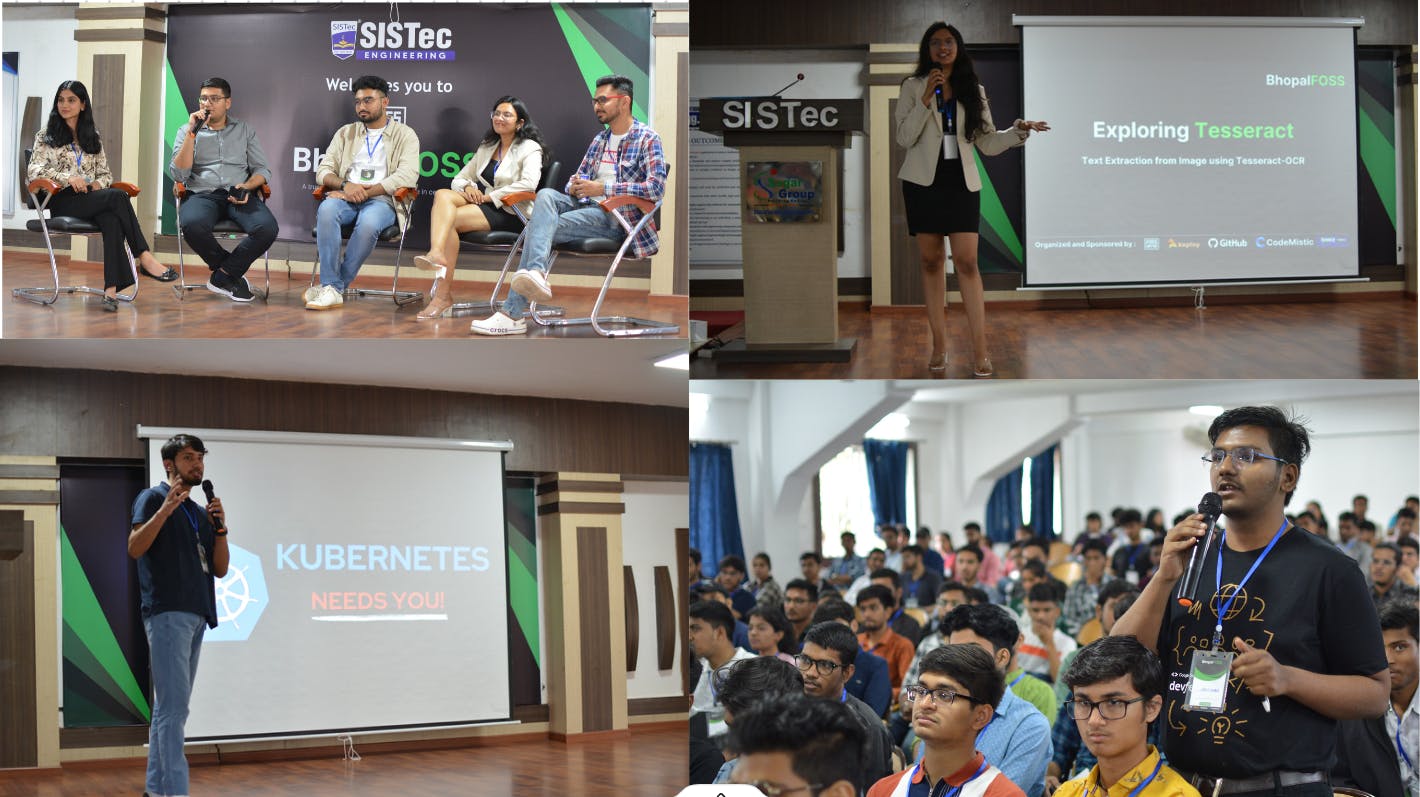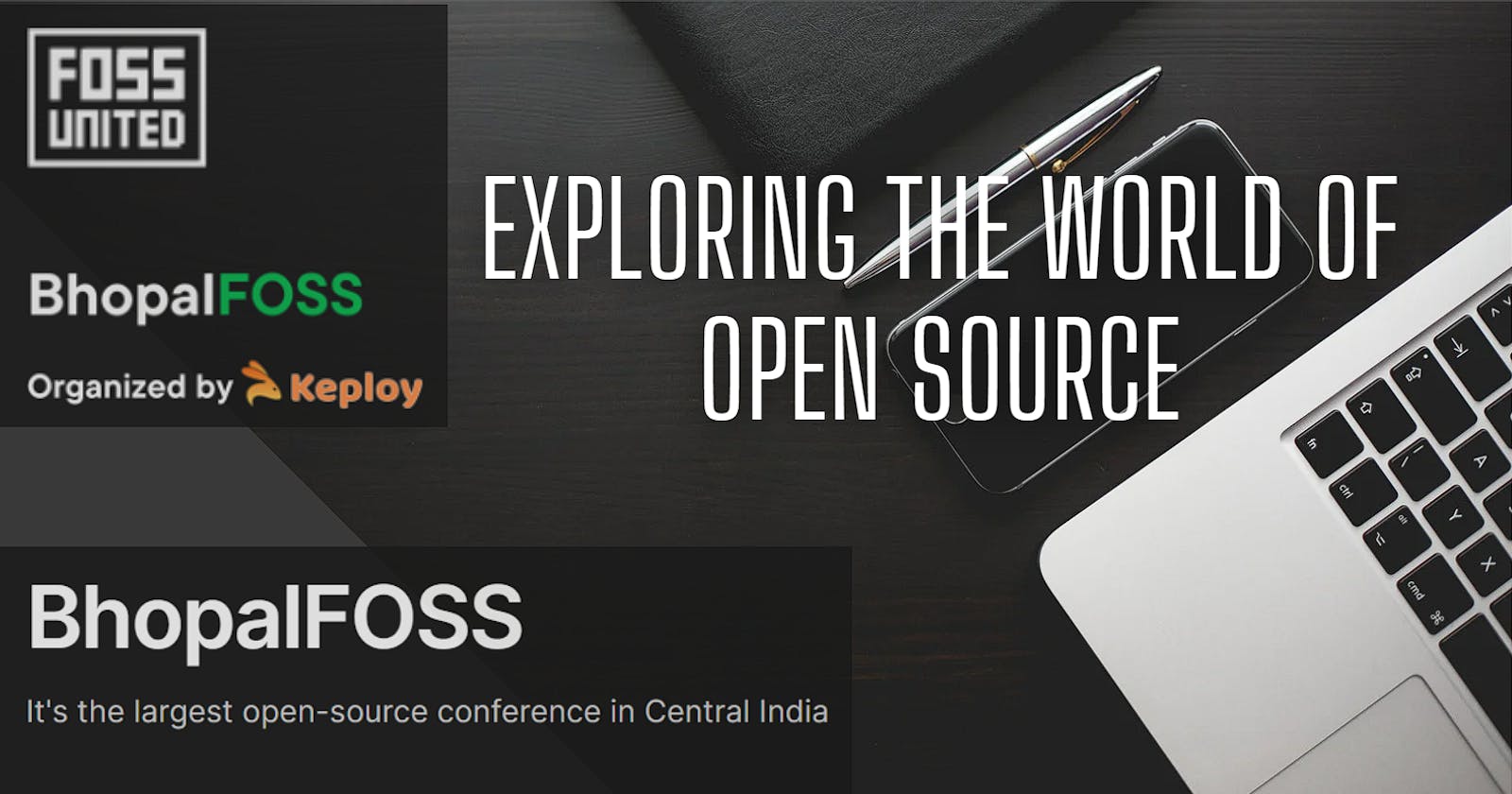Exploring the World of Open Source: My First Experience at the Bhopal FOSS, a FOSS United India Tour Open-Source Conference
Table of contents
- FOSS UNITED
- OPEN-SOURCE
- My Experience
- AGENDA: BHOPAL FOSS CHAPTER
- SPEAKERS:-
- -Nitish Kumar [Contributor @Kubernetes]:Kubernetes needs you
- -Aishwarya Suresh [Microsoft SDE Intern'22, Wells Fargo'23]:-Exploring Tesseract: Text extraction from an image using Tesseract OCR.
- -Nishant Mishra [Keploy, GSOC Mentor]:- Open Source E2E Testing for developers: KEPLOY
- -Mrinal Jain [Tech Lead at STAGE.in]:- create TV apps using cross-Platform Flutter, an Open Source tool-kit
- -Epsit Bhardwaj [Microsoft SDE Intern'23]:- GIMP-ML unlocking the power, A guide to how it works
- -Lavakush Biyani [Jr Dev Evangelist@ApacheDevLake]:- Achieving developer's efficiency on open source projects with DevLake.
- WHAT CAN ONE CONCLUDE?
You need to do it now...!!! In this blog post, I will be discussing why it is important to attend open source conferences and engage with the community, especially for those who are planning to switch or have already switched their career in the field of CS-IT. It is crucial to prioritize attending these conferences and stay engaged with the community, and I'll explain why in the following sections

FOSS UNITED
FOSS United is a non-profit organization that was established in 2020. Their aim is to promote the development of Free and Open-Source (FOSS) projects and communities in India. It started as a collaboration between the teams at Frapppe and Zerodha. Frappe is the publisher of ERPNext, which is one of the largest FOSS projects in India. The foundation has six industry partners currently, and they are open to more organizations joining them.
OPEN-SOURCE
Let me start by defining my understanding to open-source in simpler terms. So Open-source refers to software or technology that is created collaboratively and made available for anyone to use, modify and distribute. This means that the source code, or the series of instruction that make the software work, are freely available to the public, and users are encouraged to make changes and improvement to the software. Open-source technology is often developed by a community of volunteers who share a common goal of creating high-quality reliable software that is accessible to everyone. The philosophy behind open-source is that collaboration and sharing lead to better technology, innovation, and community-building.
My Experience
As someone relatively new to the world of open source, attending my first conference was both exciting and intimidating. I wasn't sure what to expect, but I was eager to learn more about this collaborative approach to software development and to connect with others who shared my interest. In this blog post. I will share my experiences from my first open-source conference and explain why I believe it is an event that others should consider attending as well.
First of all, let me say that attending an open-source conference is not just for developers or technical experts. While the content may be technical in nature, conferences often offer a range of sessions and workshops that are accessible to a variety of skill levels and interests. As someone who comes from a non-tech background. I was able to attend sessions that covered topics like open source in the use of Apache DevLake, exploring Tesseract, Kubernetes and the benefits of open source beyond software development.
Attending my first open-source conference was a new and exciting experience. Although I have been in the IT field for the last 6-7 months, currently a first-year Cloud & Security Student at Amity University Online, Noida. After completing high school in 2016, I spent time exploring different areas of interest. I considered pursuing Medicine and Law and have also been an aspirant, ultimately graduated with a degree in Geography with history and sociology. During this time, I also delved into agricultural science and prepared for several government competitive exams. Meanwhile, I have always been a tech enthusiast since my childhood time. I was eager to learn more about the open-source community, culture and the impact of this approach to technology.
AGENDA: BHOPAL FOSS CHAPTER
-Deep Dive into Trends in Open Source
-How to make your first contribution to Open-Source
-Panel Discussion over various Open-Source programs(such as GSoC)
-How to get involved in Open-Source
-Beginner-friendly sessions related to Open-Source
-Interact with the larger FOSS Community in India
-Quizzes and fun activities for attendees with giveaways

SPEAKERS:-
-Nitish Kumar [Contributor @Kubernetes]:Kubernetes needs you
One of the most intersting speaker sessions I attended was about Kubernetes, which happens to be an area of my interest. It was insightful since I had been scratching my head over Kubernetes for the past few weeks. He started by explaining why containerization came into existence and how Kubernetes helps in orchestrating containers. Containerization is the way to package an application and all its required tools and libraries together in a portable and isolated environment, which allows the application to run smoothly and consistently across different computers, servers and cloud environments. Just like how a chef can take their portable kitchen to a different location and still make the same dish, containerization allows an application to be deployed and run on different systems without worrying about conflicts and compatibility issues. It also makes it easier to manage and scale application. The speaker's standout point was when he discussed a systematic approach for beginners to contribute to open source. He explained how community groups operate, and how to get involved in an open-source community, and emphasized the importance of paying close attention to issue labels and approaching each issue differently.
-Aishwarya Suresh [Microsoft SDE Intern'22, Wells Fargo'23]:-Exploring Tesseract: Text extraction from an image using Tesseract OCR.
During the conference, she delivered an awesome presentation on Tesseract an OCR engine(Optical Character Recognition) for extracting text in multiple languages that were originally developed by HP(Hewlett Packard) in the mid-80s to mid-90s and is now maintained by Google. Tesseract is widely used for document scanning, classification, and text recognition, with the support of Unicode (UTF-8) and the recognition of over 100 languages out of the box. The presenter also explained the LSTM Neural Network (Long Short-Term Memory) used by Tesseract to recognize text in images, which is a type of Recurrent Neural Network that is particularly effective for text recognition tasks. Additionally, she introduced the audience to other fancy terms like CNN(Convolutional Neural Network), traditional ML algorithms, and language models, all of which are a part of Artificial Intelligence and Deep Learning. To put it simply, these technologies are similar to what powers Google Lens. but with Tesseract, one can view and examine the underlying source code and algorithm.
-Nishant Mishra [Keploy, GSOC Mentor]:- Open Source E2E Testing for developers: KEPLOY
He spoke about Keploy which is an open-source tool that generates test files and data mocks from API calls. He talked about how developers usually spend a lot of time writing and maintaining test cases and data mocks and managing test environments and seed data dumps for unit tests and functional testing can be frustrating and time-consuming. With Keploy, developers can create realistic test data, making it easier to test production scenarios and use cases. Also got to know about the DevRel profile, which is short for developer relations, which is a practice of building relationships between developers and a company or organization. It is a way for companies to connect with and support the developer community by providing them with resources, tools, and information. DevRel involves creating a culture of collaboration, and communication between the company and developers.
-Mrinal Jain [Tech Lead at STAGE.in]:- create TV apps using cross-Platform Flutter, an Open Source tool-kit
He talked primarily about the use of Flutter to build cross-platform applications. Specifically, he highlighted the challenge of developing apps for TVs, where each brand has its operating system with unique system requirements. He emphasized how Flutter can help overcome this challenge by providing a framework for building apps that can run on multiple platforms with minimal adjustments. Additionally, the speaker was very helpful in addressing non-technical questions and provided insightful responses with an engaging approach. One statement from the speaker that resonated with me was when he emphasized the importance of continuously upskilling throughout your career, with the job being a by-product of that effort.
-Epsit Bhardwaj [Microsoft SDE Intern'23]:- GIMP-ML unlocking the power, A guide to how it works
The speaker discussed the GIMP-ML project that aims to bring the power of machine learning to the image editing software GIMP(GNU Image Manipulation Program). It allows users to apply advanced image processing techniques such as object detection, segmentation, and style transfer to their images. GIMP-ML is built using open-source machine learning frameworks such as TensorFlow and PyTorch and provides a user-friendly interface for users to apply these techniques without requiring any programming skills. Also learned about U-Net which is a Convolutional Neural Network(CNN) that can be used to segment images and identify objects in them and has been used in GIMP-ML to help automate the process of image manipulation and analysis.
-Lavakush Biyani [Jr Dev Evangelist@ApacheDevLake]:- Achieving developer's efficiency on open source projects with DevLake.
He presented about Apache DevLake which is an open-source dev data platform used for managing data of DevOps tools. The data is collected and analyzed and represented visually to give a better understanding of the development process. This platform is designed for the developer team that wants to improve their approach toward development and bring in more data-driven practices. Apache DevLake can be queried to obtain valuable insights about the development process. It's like you get the complete visuals of your Software Development Life Cycle(SDLC). Learned about DORA matrices, and DevLake implements. In short, it is a monitoring tool that Monitors all metrics, events, logs, and traces in one place.
WHAT CAN ONE CONCLUDE?
Open-source conferences provide a unique opportunity to broaden your knowledge and engage with a variety of perspectives and experiences from professionals in the industry. Unlike traditional college settings where "time is a limiting factor", open-source conferences offer a "smooth learning curve" that motivates you to continue learning. During conferences, you have the chance to participate in hands-on experiences, engage directly with speakers, and learn from professionals. By asking insightful and categorical questions, you can gain valuable insights into their approaches, mistakes, decisions, and life experiences, as well as receive "categorical guidance". These experiences are invaluable and help you grow both personally and professionally. So keep getting uncomfortable and keep growing.
